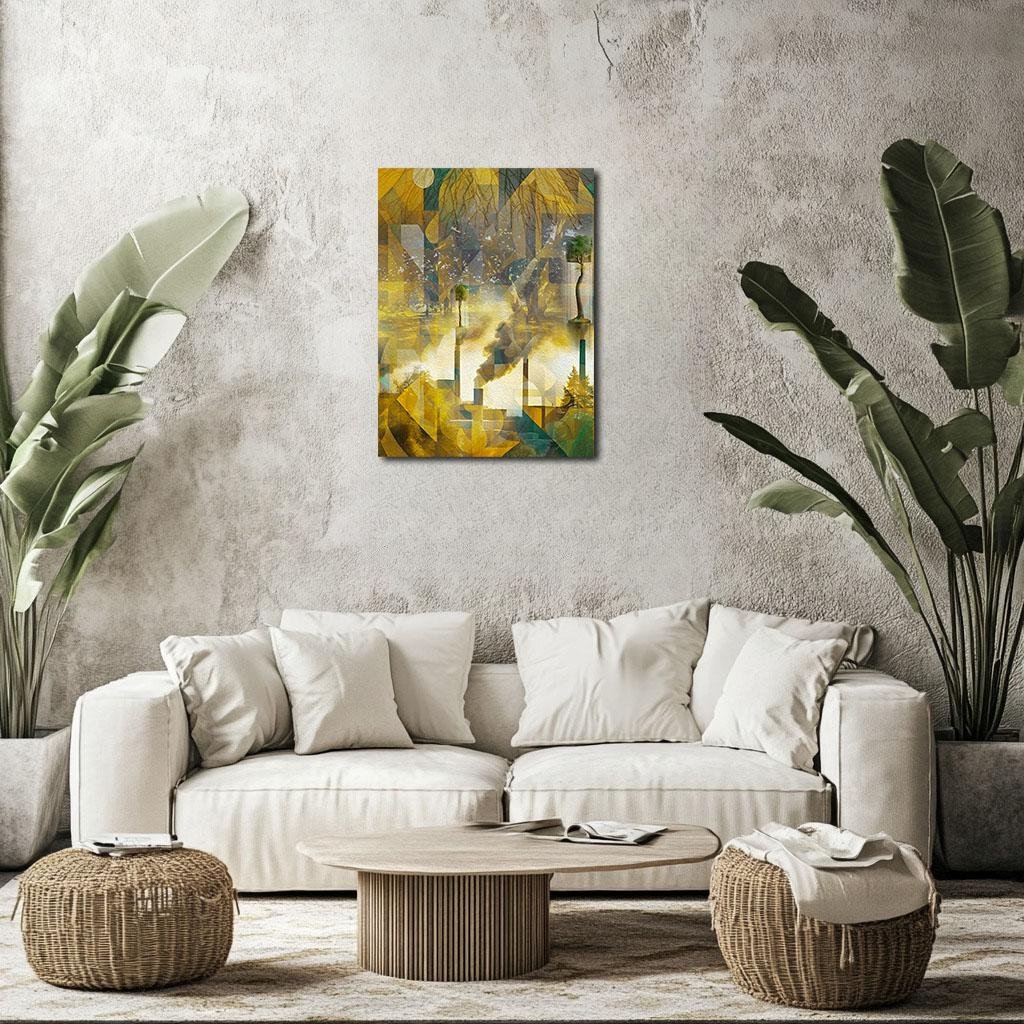The Geometry of Breath: Fontainebleau Refracted
The Geometry of Breath: Fontainebleau Refracted transforms Monet’s 1860s vision of the forest into a conceptual landscape of grids, smokestacks, and suspended trees. Nature is compartmentalized but unbroken, reframed within golden planes and quiet structures. This geometric collage explores the evolving relationship between organic memory and mechanical progress, offering a complex meditation on coexistence, adaptation, and the fragile beauty that endures through change.
Please see Below for Details…
Hotline Order:
Mon - Fri: 07AM - 06PM
404-872-4663
Claude Monet’s early studies of the Fontainebleau Forest, painted in the 1860s, reflect a reverent eye turned toward nature’s architecture—light between trees, dappled ground, the slow choreography of branches in wind. The forest was a living cathedral, vast and sacred, a place of study, retreat, and artistic humility. In this conceptual geometric reinterpretation, titled The Geometry of Breath: Fontainebleau Refracted , Monet’s organic vision is deconstructed and recomposed within a matrix of planes, prisms, and industrial incursions. What begins as a homage to natural harmony becomes a portrait of fractured coexistence—where tree and smokestack rise side by side, and the sacred rhythm of nature is filtered through grids of progress, tension, and resilience.
The composition is a layered field of contradiction. At first glance, soft light filters across forested ground, trees glow in quiet repose, and leaves scatter golden reflections. But this tranquility is quickly overlaid by a new visual system—rigid, angular, modular. Rectangles, circles, and diamonds slice through the forest like invisible scaffolding, not erasing the organic, but reframing it. The trees, once part of a unified space, are now divided by geometric borders. They appear behind translucent panes, compartmentalized like specimens under study or memories in digital storage. The forest breathes still—but through a grid of containment.
From the lower center of the canvas, smokestacks rise—not exaggerated, but real, dark, and vertical. They intrude upon the pastoral landscape with quiet certainty. One emits thick yellow smoke that rises into the geometry above, curling through the colored panels and dissolving into fractured light. The smoke does not dominate the piece. It infiltrates. It weaves itself into the patterns, like a thought that cannot be unthought. These smokestacks do not arrive with violence. They are already here, embedded in the landscape, speaking to a long-ago moment when the wild and the mechanical began to coexist beneath the same sky.
Yet amid this intrusion, a new form of growth appears. Trees, long separated from soil, now grow from platforms—cylindrical bases rising from the tops of chimneys and columns. Their trunks are narrow, twisted, and elongated, yet they stand upright, almost defiantly, silhouetted against gold-tinted smoke and mathematical space. These are not survivors. They are witnesses. Symbols of endurance that refuse to vanish, even as their roots have been lifted and repurposed. Each one balances improbably—natural forms suspended on artificial bases, a commentary on adaptation in a world increasingly shaped by abstraction.
Color in this collage is intentional and atmospheric. Golden yellows dominate, diffused and reflective, offering the illusion of warmth even as they veil a tension beneath. These are not the warm ochres of Monet’s sunlight—they are filtered, processed, cast like a digital glaze across the canvas. Cool greens and earthy blues peek through, often in shadowed corners or fragmented windows, suggesting the memory of the forest beneath the surface. The smoke is tinged with both light and sorrow. It carries form but no boundary, drifting between panels, staining the geometry as if thought itself could smudge.
The visual rhythm is driven not only by color and form, but by the juxtaposition of line and curve. Tree trunks intersect clean diagonal slashes. Leaves echo the circular glyphs faintly embedded in the background. Architecture rises from soil and pixel alike, suggesting a future where both may be indistinguishable. The entire composition oscillates between invitation and distance. You are drawn in by light and form, but held back by the invisible planes that organize the space like a code you cannot quite decipher.
As the artist, I did not seek to erase Monet’s forest, but to reimagine how we carry it forward. The Fontainebleau he painted was not only a forest, but a symbol of escape, reflection, and balance. In this work, that symbol is interrogated. What does it mean to remember a forest inside a system of progress. What happens when trees grow in spaces shaped not by root but by reason. This collage becomes a meditation on how nature is reframed—by architecture, by industry, by digital interpretation—and how it resists, persists, and ultimately becomes part of the very structure that would contain it.
The Geometry of Breath is not a lament. It is a study in transformation. It holds no illusions of return, but instead offers a vision of coexistence—tense, fragile, and essential. In this space, Monet’s trees still stand, but their light now filters through a different canopy. Not of leaves, but of logic. Not of branches, but of boundaries. And still, they breathe.
Add your review
Your email address will not be published. Required fields are marked *
Please login to write review!
Looks like there are no reviews yet.








